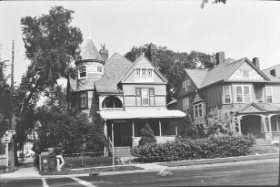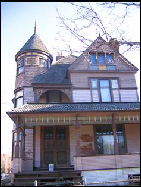Overview
The Legg House is a typical middle-class home in the Queen Anne style within a late 19th century tract housing development.
- Location: 1601 Park Avenue
- Neighborhood: Elliot Park
The Legg House is a typical middle-class home in the Queen Anne style within a late 19th century tract housing development.


The Legg House is a typical middle-class home in the Queen Anne style within a late 19th century tract housing development.
Harry Legg and his wife Dora owned a jewelry store in downtown Minneapolis on the corner of Nicollet Avenue and Fourth Street. Their home was built in 1887. It has a stone block foundation and smooth wood lap siding. There is a prominent rounded tower on the northwest corner with textured shingles. The upper floors feature several small decorative windows. The original wrap-around porch was altered to be front-facing only. The painted columns and spindlework details remain. A gabled roof, tower, wraparound front porch, and varied wall textures are common elements of the Queen Anne style.
The interior is largely the same. The butler's pantry was converted into two bathrooms. The three fireplaces on the first floor have been sealed. The home's ornate woodwork may have come from the "made to order" catalogs that were prominent at the time. Consumers could conveniently shop from the privacy of their homes with catalogs. They also provided more options for buyers to choose from without traveling.
Tract development offered a solution to Minneapolis's growing population in the late 1800s. This type of development built similar homes on smaller lots at the same time. Construction was cheaper and faster. This increased the overall supply of homes and lowered the cost of housing.
Historic Preservation
Phone
Address
Public Service Center
505 Fourth Ave. S., Room 320
Minneapolis, MN 55415